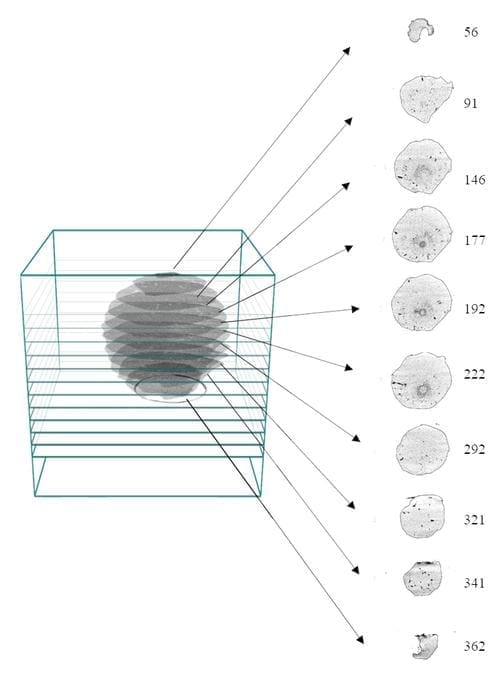A severe hailstorm that struck Catalonia in August 2022, producing giant hailstones up to 12 cm in diameter, has led to surprising discoveries about hail formation. For the first time, scientists used computed tomography (CT) scans to examine the internal structure of these massive hailstones, offering a non-invasive way to study their growth and composition. This groundbreaking technique could provide vital clues for improving predictions of future hailstorms, which cause widespread damage and pose serious risks to human safety.
Hailstones are formed during thunderstorms, when raindrops are propelled into very cold parts of a cloud, where they freeze. Once the particles are heavy enough, gravity pulls them back towards Earth. As the plummet, they grow into hailstones, which can cause injury to people and significant damage to homes and cars.
Scientists have been studying how hailstones grow since the 1960s but doing so meant breaking them in the process. To better understand the anatomy and growth of hailstones, researchers in Catalonia have used computed tomography (CT) scans to examine the giant hailstones that hit the north-east of the Iberian Peninsula during an exceptionally strong thunderstorm in the summer of 2022.

“We show that the CT scanning technique enables the observation of the internal structure of the hailstones without breaking the samples,” said Carme Farnell Barqué, a researcher at the Meteorological Service of Catalonia and lead author of the study published in Frontiers in Environmental Science. “It is the first time that we have a direct observation of the entire internal structure of hailstones, which can provide clues to improve hail formation forecasting.”
Storm hunters

After the storm hit Catalonia on August 30, 2022, the researchers tracked the storm path with the help of local witnesses and collected hailstones from observers who’d saved them in their freezers. Some of the stones measured up to 12cm in diameter.
Back in the lab, three randomly selected hailstones were scanned, using the equipment of a dental clinic. The research was funded by the Institut de Recerca de l’Aigua and a grant from Agència de Gestió d’Ajuts Universitaris i de Recerca.
“We wanted to use a technique that would provide more information regarding the internal layers of the hailstones, but without breaking the samples,” said senior author Prof Xavier Úbeda, a researcher at the University of Barcelona. “We didn’t expect to obtain as clear imagery as we got.”
By way of CT scan, a technology that uses a rotating X-ray machine to create 3D images, the researchers learned much about the external and internal structure of hailstones. 512 images – known as ‘slices’ – of each hailstone showed the location of the core and different layers.
“CT scans provide information related to the density, which allows us to identify the different stones’ layers associated with the growth stages of the hailstorm. They also help us understand the processes that contributed to its formation,” explained co-author Prof Javier Martin-Vide, a researcher at the University of Barcelona.
Anatomy of a hailstone
The researchers found that axes and planes can be irregular on the inside, even when from the outside, stones look like near-perfect spheres. Additionally, the stones’ cores were not located in the centers, especially in spherical stones.
“We show that the embryo can be located far from the center. This fact implies that the stones can grow heterogeneously in three directions,” co-author Dr Tomeu Rigo Ribas at the Meteorologic Service of Catalonia pointed out.
They also found that different layers had different density levels, and two of the samples had thicker parts, which indicates this was the side of the stone facing downwards as it fell.
These insights into the insides of hailstones overturned previous assumptions.
“Until now, it was believed that very large hailstones could only have irregular shapes. However, we observed that the external and internal shapes can differ,” said Farnell Barqué. “In one case, we have demonstrated that the sample exhibited heterogeneous growth but had a regular external shape. Conversely, stones with irregular external shapes showed homogeneous growth.”
Making CT scans, however, is expensive, and some of the resulting images show anomalies they yet have to understand, the researchers said. As more giant hail events with greater impacts on economy and people are expected in the future, they believe that their work can provide new information that may help mitigate damage to society.
Journal Reference:
Farnell Barqué C, Rigo T, Martin-Vide J and Úbeda X, ‘Internal structure of giant hail in a catastrophic event in Catalonia (NE Iberian Peninsula)’, Frontiers in Environmental Science 12, 1479824 (2024). DOI: 10.3389/fenvs.2024.1479824
Article Source:
Press Release/Material by Frontiers
Featured image: 3D representation of the three samples analyzed by CTS. Credit: Farnell Barqué et al. (2024) | DOI: 10.3389/fenvs.2024.1479824 | Frontiers




